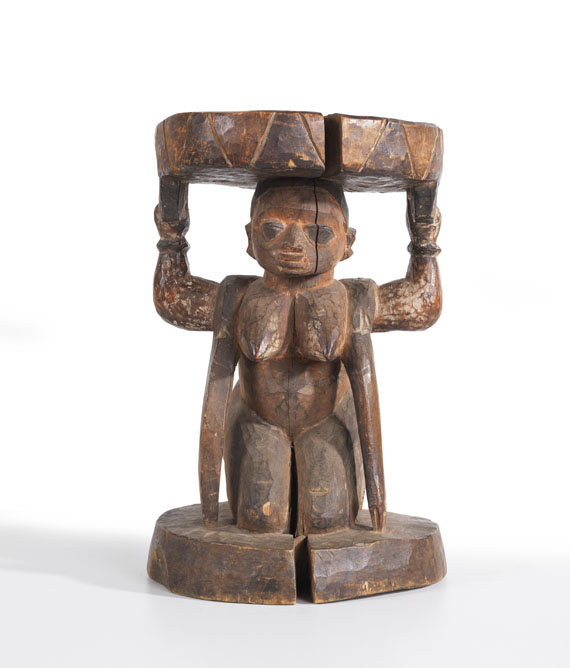Verso
Autre image
Autre image
Autre image
32
Hocker (Karyatide)
Wood painted in white, black and red. Yoruba, N...
Estimation:
€ 2,000 / $ 2,140 Résultat:
€ 13,750 / $ 14,712 ( frais d'adjudication compris)
Hocker (Karyatide).
Wood painted in white, black and red. Yoruba, Nigeria.
Height: 38.5 cm (15.1 in).
PROVENANCE: Collection Hermann Gerlinger, Würzburg (with the collector stamp).
EXHIBITION: Inspiration des Fremden. Die Brücke-Maler und die außereuropäische Kunst, Stiftung Moritzburg, Kunstmuseum des Landes Sachsen-Anhalt, Halle (Saale), November 13, 2016 - January 29, 2017, cat. no. 15 (with illu. on p. 43).
LITERATURE: Heinz Spielmann (editor), Collection Hermann Gerlinger, Stuttgart 1995, p. 439, cat. no. I (with illu.).
Hermann Gerlinger, Katja Schneider (editors), Die Maler der Brücke. Inventory catalog Collection Hermann Gerlinger, Halle (Saale) 2005, p. 417, SHG no. 899 (with illu.).
Wood painted in white, black and red. Yoruba, Nigeria.
Height: 38.5 cm (15.1 in).
PROVENANCE: Collection Hermann Gerlinger, Würzburg (with the collector stamp).
EXHIBITION: Inspiration des Fremden. Die Brücke-Maler und die außereuropäische Kunst, Stiftung Moritzburg, Kunstmuseum des Landes Sachsen-Anhalt, Halle (Saale), November 13, 2016 - January 29, 2017, cat. no. 15 (with illu. on p. 43).
LITERATURE: Heinz Spielmann (editor), Collection Hermann Gerlinger, Stuttgart 1995, p. 439, cat. no. I (with illu.).
Hermann Gerlinger, Katja Schneider (editors), Die Maler der Brücke. Inventory catalog Collection Hermann Gerlinger, Halle (Saale) 2005, p. 417, SHG no. 899 (with illu.).
At the end of the 19th century, chancellor Otto von Bismarck established German protectorates in South West Africa, Cameroon, Togo and German East Africa. Officials, travelers, traders and missionaries brought numerous art- and cult objects from the colonies to Germany. At the same time, ethnographic museums were founded in Germany, for example in Dresden, Leipzig, Berlin and Hamburg. And businesses were set up, such as the trading house Gustav Umlauff in Hamburg, which traded in natural and ethnographic objects. The ethnological museums showed the artefacts and cultural objects from non-European cultures, in addition to Africa, from South and Latin America, and Oceania. The inventories grew rapidly in just a very short time. Masks, figures, stools, tobacco pipes, but also weapons, musical instruments and clothes were presented in overcrowded showcases. When the objects arrived, their meaning and purpose were usually not identified any closer. Only the Ethnological Museums made efforts to explain them to their visitors, including the Brücke artists. Around 1900, this new type of ethnological museum triggered a special fascination and curiosity. These museum collections, which were still far from an objective, scientifically based presentation, often were the first points of contact with non-European works of art for many artists. Pablo Picasso, for example, discovered art from Africa in the Musée d'Ethnographie in the Trocadéro Palais in Paris, which inspired him significantly to one of his early major works, the "Demoiselles d'Avignon" from 1907. In the same way, the Brücke artists were fascinated by the collection of the Dresden Museum of Ethnology. The Brücke artists not only looked at the objects in museums, they also collected them. Fascinated by the direct expressiveness of the formal language of these objects, they discovered a new aesthetic for their work, which they implemented in their sometimes radical form and image inventions. Preserved documents tell about the discovery of non-European art in the circle of the Brpcke. Around 1910, Ernst Ludwig Kirchner wrote several letters and postcards to Erich Heckel and reported on the discoveries he had made at the Ethnological Museum and illustrated sketches based on, for example, African sculptures. His drawing of the oceanic palau beams show how much Kirchner was concerned with the subject and how he advised Heckel of his 'discovery'. Kirchner not only studied the original artefacts, he also studied publications with picture plates, which is reflected in Kirchner's sketchbooks. Sketches of this type by Heckel have not survived. The collection of books in his studio, which contained numerous titles on the art of the cultures of the world, was completely destroyed in an air raid in Berlin in 1943.
This stool in the shape of a caryatid comes from what is now West African Nigeria, where the Yoruba people live. A kneeling, undressed woman lifts a thick wooden panel over her head, the round seat; her physical exertion is softened and cushioned with two supports reaching from the shoulders to the ground. The figure, coarsely cut out of wood in an expressionist manner and decorated with a simple line ornament, used to be painted, as remains of white, red and black paint are still visible. With the aesthetics of exotic sculptures, the artists of the Brücke expanded the hitherto canon of art. This approach is reflected in the Hermann Gerlinger Collection. [MvL]
This stool in the shape of a caryatid comes from what is now West African Nigeria, where the Yoruba people live. A kneeling, undressed woman lifts a thick wooden panel over her head, the round seat; her physical exertion is softened and cushioned with two supports reaching from the shoulders to the ground. The figure, coarsely cut out of wood in an expressionist manner and decorated with a simple line ornament, used to be painted, as remains of white, red and black paint are still visible. With the aesthetics of exotic sculptures, the artists of the Brücke expanded the hitherto canon of art. This approach is reflected in the Hermann Gerlinger Collection. [MvL]
32
Hocker (Karyatide)
Wood painted in white, black and red. Yoruba, N...
Estimation:
€ 2,000 / $ 2,140 Résultat:
€ 13,750 / $ 14,712 ( frais d'adjudication compris)




 Lot 32
Lot 32 